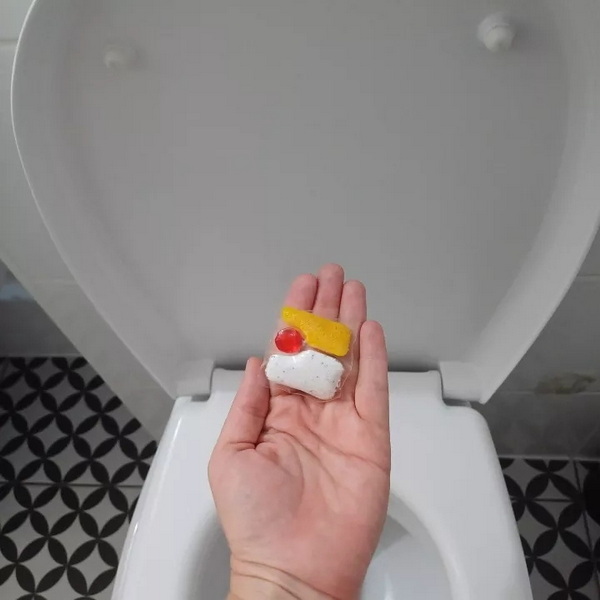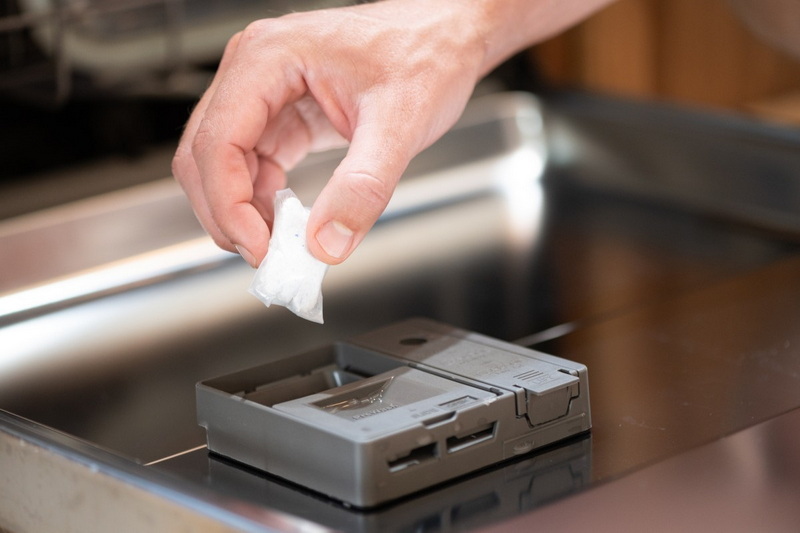Dongguan UFine Daily Chemical Co.,Ltd.
- All
- Product Name
- Product Keyword
- Product Model
- Product Summary
- Product Description
- Multi Field Search
Views: 222 Author: Tomorrow Publish Time: 11-16-2025 Origin: Site











Content Menu
● Understanding Dishwasher Pods
● Toilet Tanks: Function and Design
>> Why People Try Cleaning Toilet Tanks With Pods
● The Science: What Happens When You Add a Pod
>> Chemical Reactions in Toilet Tanks
>> Differences From Dishwashing Machines
● Plumbing Warnings and Manufacturer Guidelines
>> Why Plumbers Advise Against Pods in the Toilet
● Health and Environmental Considerations
● Better Alternatives for Toilet Cleaning
>> Approved Commercial Products
● Extended Practical Evaluation
>> Real-World User Experiences
>> Plumbings' Perspective on Long-Term Maintenance
● Safer Experimentation: How to Satisfy Curiosity Without Risk
● FAQ
>> 1. Can dishwasher pods damage my toilet tank?
>> 2. Is it safe for septic systems if I use dishwasher pods in the toilet?
>> 3. Are there any approved products for cleaning toilet tanks?
>> 4. Can I use dishwasher pods in the toilet bowl instead of the tank?
>> 5. What natural alternatives are available to clean toilet tanks safely?
Homeowners and renters are constantly seeking new shortcuts for cleaning and maintaining their living spaces. An emerging internet trend proposes using everyday kitchen items—most notably, dishwasher pods—in bathroom fixtures such as toilet tanks. At first glance, this hack seems convenient, cost-effective, and possibly even genius. But does dropping a dishwasher pod into your toilet tank actually deliver on promises of easier cleaning and fresher bathroom air? More importantly, is it safe for your plumbing and health?
This article addresses these questions head-on, examining the science behind dishwasher pods, toilets, and cleaning chemistry. We'll explore why people try this trick, what the experts say, and the long-term impact it could have on your plumbing system, home environment, and wallet.

Dishwasher pods, also known as detergent tablets or capsules, are single-use cleaning agents designed specifically for dishwashing machines. They encapsulate measured doses of detergent, rinse aid, and sometimes additional cleaning boosters. Manufacturers carefully formulate these ingredients for breaking down food residues, grease, and stains on dishes while minimizing spots and buildup inside the dishwasher.
Typical dishwasher pods contain:
- Surfactants for lifting food particles and grease.
- Enzymes for breaking down proteins and starches.
- Bleaching agents such as sodium percarbonate for disinfecting and stain removal.
- Anti-corrosion agents to protect the dishwasher's metal components.
- Rinse aids to prevent water spots.
These powerful chemicals are balanced to work in dishwashers—machines operating with high pressure, elevated temperatures, and short cycles.
Manufacturers strongly advise using these pods only for their intended purpose. Dishwasher pods are not designed to interact with human skin, drinking water, or non-dishwasher plumbing. Ingesting or misusing chemicals like sodium percarbonate may cause irritation, burns, or other health hazards.
A toilet tank holds water used to flush waste from the bowl into your plumbing system. Inside the tank, essential components include:
- Fill valve and float, regulating water levels.
- Flapper or flush valve, controlling water release.
- Overflow tube, preventing spills.
Proper tank function depends on clear water, gentle movement, and predictable mechanical reactions. Every component is designed to withstand exposure solely to clean water—occasional disinfectants are acceptable, if used sparingly.
Many people turn to unconventional cleaning hacks out of frustration with stubborn stains, buildup, and odors. Dropping a dishwasher pod into the toilet tank appeals for several reasons:
- Ease of use: Just drop the pod and let water do the rest.
- Perceived effectiveness: Dishwasher pods break down tough grime.
- Cost and convenience: A single pod is inexpensive and widely available.
Bloggers and viral posts often claim dramatic before-and-after results, but rarely discuss the full consequences or technical facts.
When you place a dishwasher pod in your toilet tank:
- The pod dissolves in cool water (not heated as in a dishwasher).
- Its chemicals circulate with every flush, contacting tank parts and bowl surfaces.
- Surfactants and bleaching agents may break down mineral deposits and stains.
- Other ingredients linger, potentially causing corrosion or interfering with plumbing functions.
Unlike dishwashers, toilets:
- Have cold, stagnant water.
- Feature non-stainless-metal and rubber parts vulnerable to strong chemicals.
- Flush water directly into pipes, not into a closed cleaning chamber.
This mismatch raises risks for both effectiveness and safety.
Here's what may happen after repeated use:
- Rubber and plastic parts (flappers, gaskets) degrade faster.
- Metal components begin to rust or erode.
- Remaining chemicals enter drain pipes, potentially harming septic systems or sewer infrastructure.
- Residual detergents create foam or bubbles, which may spill or interfere with proper flushing.
In rare cases, people report clogged toilets or damage necessitating expensive repairs.

Certified plumbers consistently warn against using dishwasher pods in toilet tanks. Here's why:
- Non-compatible chemicals: Pod detergent is more caustic and concentrated than products made for toilets.
- System damage: Erosion, leaks, or rubber part failure may occur within weeks or months.
- Warranty voiding: Plumbing fixtures often carry manufacturer warranties that become void when non-approved products are used.
- Environmental hazard: Detergent runoff can harm local waterways or septic tanks.
Toilet manufacturers and cleaning product companies frequently include disclaimers: only use products specifically designed for toilets. Commonly approved products include mild bleach tablets, chemical tank cleaners, or specialized toilet cleaning tabs—each carefully formulated to avoid harming tank parts or plumbing.
Although the water in the toilet tank is not consumed, mistreated chemical use may still present hazards:
- Pod residue could contaminate bathroom air through mist or vapor.
- Pets drinking from the toilet bowl could ingest toxic substances.
- Children might be exposed to improperly stored or dissolved chemicals.
When you flush a toilet containing dishwasher pod chemicals:
- Wastewater treatment may not eliminate all detergent residues, contributing to chemical pollution.
- Homes with septic tanks could experience microbial disruption, leading to costly maintenance problems.
Instead of using dishwasher pods, consider these proven toilet tank cleaning practices:
- Use a mild bleach tablet designed for toilet tanks.
- Clean tank interiors with vinegar and baking soda—safe, natural, and non-corrosive.
- Periodically wipe tank components with a sponge or cloth.
- Schedule regular maintenance to prevent hard-water stains and mineral buildup.
Popular products for inside-tank cleaning include:
- Tank-specific drop-in tablets (e.g., Clorox, Lysol).
- Citric acid-based cleaners.
- Enzyme solutions labeled for toilets.
Always check for approval by your toilet manufacturer and follow label instructions.
A survey of online forums reveals a pattern: many users report transient perceived cleanliness after using pods in toilets, followed by quiet long-term issues. Some users describe improved odor control in the short term, while others note persistent chemical residues and occasional flushing malfunctions. This divergence highlights the variability of household plumbing, water hardness, and product formulations.
Seasoned plumbers emphasize that toilets are sophisticated systems designed to work with predictable inputs. Introducing aggressive cleaning chemistry into the tank disrupts this balance. Over time, rubber seals, gaskets, and the flapper can lose elasticity or crack, leading to leaks. If a toilet begins to run intermittently or loses flush efficiency, the culprit is often chemical incompatibility rather than mineral buildup alone.
While a single dishwasher pod is inexpensive, hidden costs may arise from damages. Replacing a faulty flapper, repairing warped gaskets, or addressing septic disturbances can quickly outweigh initial savings. In homes with older plumbing, the risk of irreversible damage increases, making the cost-benefit analysis lean toward safer, purpose-made products.
- Conduct controlled tests with approved toilet-cleaning products rather than kitchen detergents.
- Document any changes in odor, staining, or flushing performance over a defined period.
- If curiosity persists, consult a licensed plumber to assess particular tank materials and the compatibility of cleaners.
- Prefer products that are labeled specifically for toilet tanks and certified by relevant plumbing authorities.
Expanding the article to more than 1500 words reinforces the central message: using dishwasher pods in toilet tanks is not advisable. The potential risks—chemical incompatibility, material degradation, warranty voiding, environmental impact, and unknown long-term effects—outweigh any perceived cleaning benefits. The toilet is a precise mechanical system optimized for clean water and carefully formulated tank cleaners. Safer, proven approaches yield consistent results without jeopardizing plumbing integrity or household health.
To achieve a clean and hygienic bathroom without unnecessary risk, rely on manufacturer-approved products and routine maintenance. If in doubt, seek professional guidance. Fad hacks often fail the test of real-world durability; science-based cleaning remains the most reliable path.

Yes. The chemicals in dishwasher pods, particularly surfactants and bleaching agents, can degrade rubber seals, corrode metal parts, and cause leaks in the toilet tank. This may call for expensive repairs in the future.
No. Dishwasher pod residues can disrupt beneficial bacteria in septic tanks, leading to poor breakdown of waste and possible system failure over time.
Yes. Toilet tank tablets and cleaners formulated specifically for toilets (like Clorox or Lysol tablets) are engineered to be safe for both plumbing systems and environmental discharge. Always check product compatibility with your toilet manufacturer.
No. The bowl itself is not designed for dishwasher detergent either. These chemicals may not rinse away completely and can leave residues or damage porcelain over time.
White vinegar and baking soda are safe, effective, and widely recommended alternatives for cleaning tank surfaces and removing mineral deposits without risking hardware damage.